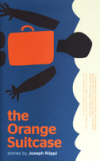the Orange Suitcase
In a collection that falls somewhere between linked short stories and poetic reflections, Joseph Riippi explores, through the words and story of a young man who shares his name, the strangeness of knowing so much about someone but also not knowing them at all—which is in a way true of so many relationships.
In a collection that falls somewhere between linked short stories and poetic reflections, Joseph Riippi explores, through the words and story of a young man who shares his name, the strangeness of knowing so much about someone but also not knowing them at all—which is in a way true of so many relationships.
Riippi opens the Orange Suitcase with the epigraph “Let’s start again,” like stories being told and retold until the telling of the story is as much about remembering the story as it is about what happens in it. It also recalls the questionability of getting a story “right,” and whether this is even possible. He titles his stories colloquially, beginning each title with “something,” as in “Something About a Joke,” or “Something about Borges and the Blind in Chelsea.” He also chooses to encapsulate his story titles with quotation marks, a nod to the oral, conversational nature of storytelling.
The intimacy of the Orange Suitcase lies in how it is not a complete portrait of any of the characters of the story—not the narrator, not his family, not his former or current friends, girlfriends. Various named characters appear, disappear, and reappear in the stories at different points of the book, and in fact, many of the stories are “something about” these characters. One character, Ben Jensen, haunts the collection with his presence and his absence. The story entitled “Something about Ben Jensen” shows the musicality and vividness of Riippi’s prose:
So he isn’t dead. That’s what I thought when I saw Ben Jensen today. It happened on the bus, the 14D. I was sitting with my feet against the back wheel-well and trying to read someone else’s poems.
Riippi skillfully invokes particular people and emotions through certain items, the way leitmotif works in a musical piece or costuming a color for a character in a film. In this way, the Orange Suitcase is quite cinematic and sensory; Ben Jensen, for example, is associated with “red fingerless gloves rolling cigarettes.” Another of these items is the titular orange suitcase, introduced in the first story (narrated by Joseph’s grandmother, who talks about meeting and loving his grandfather). It takes a while to resurface, among Legos, and in a dream, as Joseph himself is approaching his marriage.
New York City, too, serves as backdrop and metaphor; throughout the Orange Suitcase, it marks change and movement. Full-page, black-and-white photographs are scattered through his stories, and several are of the streets or intersections in New York that Riippi mentions as the sites of various occurrences. The photographs do not always correspond directly with the stories that they precede or follow, and by lying outside of the chronology of the stories, the reader is asked to remember why a particular picture is relevant. In doing so, the reader makes the connection between events of previous stories and the upcoming story.
“My heart felt tremendous in my chest, growing, hugely inflating, and then everything broke,” Riippi writes, in “Something About A Promise.” Much like the act of remembering, the experience of the Orange Suitcase is lovely but a bit sad, one likely to make its reader miss both the people of the past and past versions of self.





